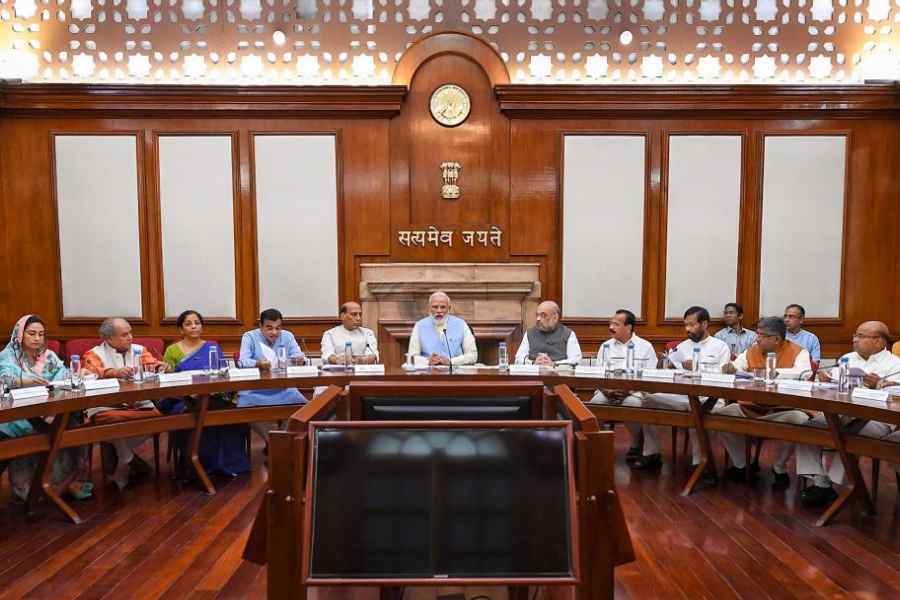Prime Minister Narendra Modi is the tallest political leader in the country. He totally controls the ruling Bharatiya Janata Party. There are states where other politicians have been able to maintain their hold despite the BJP’s assertive forays but on an all-India basis it is Modi who enjoys the greatest popularity. Besides, while in the past, the popular perception was that the balance of influence between Rashtriya Swayamsevak Sangh leaders and those of the BJP tilted in the former’s favour, now, clearly, it is Modi who looms large over the RSS. All these points came to the fore in the days preceding the pran pratishtha of the deity, Balak Ram, installed in the grand Ram mandir under construction in Ayodhya and, especially, during the ritual. The entire focus was on Modi even though he was not the principal jajman during the ceremony. The BJP and the sangh parivar lavished unprecedented praise on Modi for achieving, what they called, a five-century-long national aspiration.
In light of the above factors, it was not unnatural for the cabinet to adopt a resolution on January 24 praising Modi for the construction of the Ram mandir. Anurag Thakur, the minister for information and broadcasting, informed the media that the defence minister, Rajnath Singh, read out a resolution on behalf of his cabinet colleagues commending the prime minister’s great accomplishment. Singh is the senior-most minister in the cabinet; it was only fitting that he had the privilege of moving the resolution. Clearly, Thakur implied that Modi had had no hand in the crafting of the resolution that so greatly honoured him. Modi’s cabinet colleagues were perhaps comforted by the thought that they echoed the sentiments of a great number of Indians who feel that but for Modi the Ram mandir would not have been constructed.
It would have been ungracious of Modi to pour cold water on this cabinet resolution. Besides, he is not the first prime minister to have been put in such an awkward position. In 1955, a Bharat Ratna was conferred upon Prime Minister Jawaharlal Nehru. Reports of the time indicate that President Rajendra Prasad personally took the decision to do so. Nehru has been criticised for accepting the award while in office. Perhaps he too was caught in a situation where he could not refuse the honour. Indira Gandhi was also conferred the Bharat Ratna on December 18, 1971, two days after the surrender of Pakistani troops in Dhaka to the Indian army. It is said that this decision was taken by the then president, V.V. Giri. Now, Bharat Ratna awards are very different from a cabinet resolution praising a prime minister but the common factor is that the prime ministers concerned may have been compelled to accept the praise lavished on them even if they were embarrassed by it. This is because they are the head of government and cabinet decisions or those to give awards have to be taken with their approval.
The present resolution stated inter alia that Modi was chosen by destiny for the pran pratishtha. It noted that such great religious work (anushthan) could only be achieved by a person who was endowed with god’s (prabhu’s) grace. The resolution quoted Goswami Tulsidas to establish that as Modi possessed Rama’s benevolence, he had the trust of all. Tulsidas had written “Ja par kripa Ram ki hoi, ta par kripa kare sab koi.” The cabinet applauded Modi’s eleven days’ rituals and his travels to spiritual places associated with Rama to prepare for the pran pratishtha. These visits had imparted energy to India’s solidarity. The resolution hailed Modi not only as a leader of the people but also as the initiator of a new age.
Along with the rich compliments to the prime minister, the cabinet resolution commented on the significance of the January 24 cabinet meeting itself. It called it historic. In doing so, it used a formulation which was strange. It claimed that “Historic acts would have taken place many times but ever since this cabinet system has been established and even if we add to this the period of the Viceroy’s Executive Council such an occasion would never have come.” There is a fundamental difference between the ‘cabinet system’ of a body that was at the apex of an enslaved India’s executive and the cabinet of the Indian republic. Hence, what was the logic of the reference to the Viceroy’s Executive Council?
It would not be out of place to recall that the Viceroy’s Executive Council adopted the ‘cabinet system’ of allocating portfolios to its members in 1861. All its members then were Britishers. Later, Indians were also appointed members of the Council and in 1946, when an interim government was formed, Nehru became its vice-president. What is not often recalled is that even though August 15, 1947 marked a transfer of power and India became an independent dominion, the British monarch continued to be India’s head of State. The establishment of the republic on January 26, 1950 put the cabinet on an entirely different footing for it now came under the Constitution. Hence, to recall the Viceroy’s Executive Council along with the cabinet of the republic was not desirable. The cabinet resolution should be modified for it is wrong to even unintentionally imply that the republic’s cabinet is part of a continuum which started during British rule.
Furthermore, the cabinet resolution goes on to state “We can say that this country’s body became independent in 1947 and now in this the pran pratishtha of atma (soul) has been done.” It is doubtful if any individual, organisation, institution or political party has ever made such a claim. Its implications are deep and disturbing.
If a body is without atma, it is necessarily without pran. Can such a body be considered to be alive? Does the resolution then imply that till January 22, 2024 there was no life in the ‘body’ of India? And if India was lifeless, how could it be considered to be independent? Another question arises. Does the formulation mean that all those who dedicated their lives for India’s freedom did not impact the atma of India? It should never be forgotten that these freedom fighters included Mahatma Gandhi, the father of the nation, who worked not only for political freedom but also the comprehensive regeneration of India.
There is another issue with this sentence and its sentiment. It entirely ignores the establishment of the Constitution in 1950 which, it can be contended, contains the aspirations of the Indian people and the spirit which they wished should imbue all Indians individually and collectively. It can be asserted without hesitation that upholding the Constitution is the first duty of the cabinet.
The Ayodhya temple fulfils the longing of millions of Indians. Rama is part of the warp and weft of India’s life. His message of righteous conduct at all times and by everyone is an immeasurably precious heritage. Hence, above all, the Ram mandir should always remind us of what Rama stood for — compassion, duty and, when necessary, to fight for what is right.
Vivek Katju is a retired Indian Foreign Service officer











